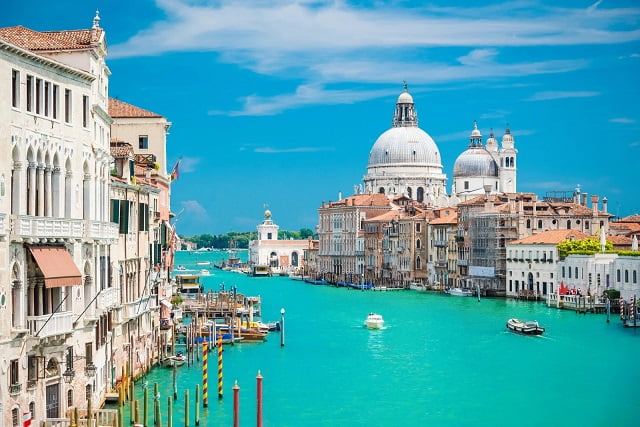Citizens worldwide are eager to resume international travel, but with the ongoing COVID-19 pandemic, many are left wondering if they can travel to Italy. This article will provide an overview of the current travel restrictions and guidelines for citizens wanting to travel to Italy. It will cover specific requirements, COVID-19 testing and quarantine protocols, vaccination requirements, travel insurance recommendations, entry and exit requirements, as well as health and safety guidelines.
As countries continue to navigate the challenges posed by the COVID-19 pandemic, Italy has implemented specific measures for travelers entering the country. Whether you are a citizen or resident looking to visit Italy for leisure or business, it is essential to understand and comply with these regulations. From documentation requirements to health protocols, this article will help you navigate the current landscape of traveling to Italy.
Italy has put in place various measures to ensure the safety of its residents and visitors. Understanding these regulations is crucial for citizens considering a trip to Italy. This article aims to provide clarity on the current travel restrictions and guidelines in place for those wishing to visit this beautiful Mediterranean country.
Overview of Travel Restrictions
Traveling to Italy as a citizen from another country is possible, but there are specific requirements and restrictions in place that must be followed. Currently, Italy has implemented travel restrictions due to the COVID-19 pandemic, and citizens traveling to the country must adhere to these guidelines. It is important to stay updated on any changes or updates to these restrictions before planning a trip.
Citizens traveling to Italy are required to fill out a self-declaration form before entering the country. This form includes information about the traveler’s health status and any recent travel history. Additionally, citizens may be required to show proof of a negative COVID-19 test taken within a specified timeframe before their arrival in Italy. Failure to comply with these requirements can result in denied entry into the country.
In addition to the self-declaration form and negative COVID-19 test, citizens traveling to Italy may also be subject to quarantine upon arrival. The duration of quarantine can vary based on the traveler’s vaccination status and specific travel history. It is important for citizens planning a trip to Italy to understand and prepare for these potential quarantine requirements in advance.
| Travel Restrictions | Requirements |
|---|---|
| Self-Declaration Form | Completed before entering Italy |
| COVID-19 Test | Negative test result required |
| Quarantine | Potential requirement based on traveler’s vaccination status and travel history |
COVID-19 Testing and Quarantine
With the ongoing COVID-19 pandemic, travelers entering Italy are subject to specific testing and quarantine protocols to prevent the spread of the virus. These measures aim to ensure the safety of both visitors and residents within the country. It is crucial for citizens considering travel to Italy to be aware of these requirements and any updates or changes that may occur due to the evolving nature of the pandemic.
Testing Requirements
Citizens traveling to Italy are typically required to present a negative COVID-19 test result upon entry into the country. The test must be taken within a specified timeframe before departure, usually within 48-72 hours. This requirement helps to detect and prevent potential cases of COVID-19 from entering Italy, reducing the risk of transmission.
Quarantine Protocols
In addition to testing requirements, travelers entering Italy may be subject to quarantine protocols based on their vaccination status and current regulations. Unvaccinated or partially vaccinated individuals
Updates and Changes Due to the Pandemic
As the situation surrounding COVID-19 continues to evolve, travelers should remain informed about any updates or changes in testing and quarantine protocols for entering Italy. It is recommended for citizens planning travel to regularly check official government websites, airline notifications, and travel advisories for the latest information related to COVID-19 measures in Italy. Staying informed about any new developments
Vaccination Requirements
Italy has implemented specific vaccination requirements for citizens wanting to travel to the country. As of the current regulations, travelers are required to provide proof of vaccination against COVID-19 in order to enter Italy. This requirement applies to both citizens and foreign visitors, and it is essential for individuals to demonstrate their vaccination status in accordance with Italy’s guidelines.
In order to prove vaccination status, travelers to Italy must present a valid vaccination certificate that shows they have been fully vaccinated against COVID-19. The accepted vaccines include those authorized by the European Medicines Agency (EMA), such as Pfizer-BioNTech, Moderna, AstraZeneca, and Johnson & Johnson. Additionally, travelers who have received a complete course of any vaccine included on the World Health Organization’s (WHO) Emergency Use Listing can also meet the vaccination requirements for entry into Italy.
It is important for citizens planning to travel to Italy to ensure that their vaccination documentation meets the country’s criteria. This may involve obtaining an official certificate from healthcare providers or government authorities in their home country. Travelers should also be prepared to present their vaccination records upon arrival in Italy as part of the entry process.
| Vaccination Requirements | Information |
|---|---|
| Accepted Vaccines | Pfizer-BioNTech, Moderna, AstraZeneca, Johnson & Johnson |
| Other Accepted Vaccines | Vaccines included on the World Health Organization’s Emergency Use Listing |
| Documentation Needed | Official certificate from healthcare providers or government authorities |
Travel Insurance
Importance of Travel Insurance
Travel insurance is an essential aspect of planning a trip to Italy. It provides coverage for unexpected events such as trip cancellations, medical emergencies, and lost or stolen belongings. While no one wants to think about potential mishaps while traveling, having adequate travel insurance can provide peace of mind and financial protection in case of any unforeseen circumstances.
Recommended Coverage
When considering travel insurance for a trip to Italy, it is important to look for a policy that includes coverage for medical expenses, emergency medical evacuation, trip cancellation/interruption, and travel delay. Additionally, considering the ongoing COVID-19 pandemic, it is advisable to find a policy that offers coverage related to COVID-19 such as trip cancellations due to illness or quarantine requirements.
Selecting the Right Policy
Before purchasing travel insurance for a trip to Italy, citizens should carefully read through the policy details and understand what is covered. It’s also important to compare different policies from reputable providers to ensure they are getting the best coverage for their specific needs. Factors such as trip duration, activities planned in Italy, and pre-existing health conditions should all be taken into consideration when selecting the right policy.
By obtaining comprehensive travel insurance that meets their specific needs, citizens traveling to Italy can ensure they are adequately protected throughout their journey.
Entry and Exit Requirements
Citizens traveling to Italy need to be aware of the entry and exit requirements, including visa information and specific guidelines for returning to their home country. Whether it’s for business, tourism, or visiting family, understanding the necessary documentation and approval processes can make the travel experience smoother.
For citizens of some countries, a visa may be required to enter Italy. It’s essential to check with the Italian consulate or embassy in your home country to determine if you need a visa for your trip. Additionally, travelers should ensure that their passport is valid for at least six months beyond their planned date of departure from Italy.
When returning to their home country from Italy, citizens should also be aware of any specific guidelines or requirements. This may include COVID-19 testing upon arrival, quarantine protocols, or completion of health declaration forms. It’s important to stay informed about any travel restrictions and guidelines implemented by the local authorities in both Italy and your home country.
In addition to visa and entry/exit requirements, travelers are advised to carry proof of travel insurance coverage when entering Italy. While it may not be a strict requirement for entry into the country, having adequate travel insurance can provide peace of mind and financial protection in case of unexpected circumstances such as medical emergencies or trip cancellations.
Health and Safety Guidelines
When preparing for a trip to Italy, it is essential to consider the health and safety guidelines to ensure a smooth and enjoyable travel experience. Here are some tips and recommendations for citizens traveling to Italy, including how to stay safe and healthy during their visit:
- Stay Informed: Before traveling to Italy, it is important to stay informed about the current COVID-19 situation in the country. Keep up-to-date with any travel advisories or restrictions that may be in place, and adhere to the guidelines set by the Italian government.
- Follow Health Protocols: While in Italy, it is crucial to follow all health protocols and guidelines, including wearing face masks in public spaces, practicing good hand hygiene, and maintaining physical distancing. Familiarize yourself with any specific rules or regulations that may be in place at your destination.
- Seek Medical Assistance if Needed: If you experience any health issues during your stay in Italy, seek medical assistance promptly. Familiarize yourself with the local healthcare facilities and emergency contact information, as well as any specific COVID-19 testing or treatment protocols that may be in place.
Remember that staying informed, following health protocols, and seeking medical assistance when needed are key factors in ensuring a safe and healthy travel experience in Italy. By being mindful of these guidelines, travelers can make the most of their time in this beautiful country while prioritizing their well-being.
Conclusion
In conclusion, citizens who are considering travel to Italy should be aware of the current restrictions and guidelines in place due to the ongoing COVID-19 pandemic. It is important to stay informed about any updates or changes to travel requirements, including documentation, testing, vaccination, and quarantine protocols. As of now, citizens can indeed travel to Italy, but they must adhere to the necessary procedures to ensure a safe and smooth entry into the country.
It is crucial for travelers to thoroughly research and understand the specific requirements for entering Italy, including any required COVID-19 testing and quarantine measures. Additionally, staying up-to-date on vaccination requirements and how to prove vaccination status will be essential for a hassle-free travel experience. Furthermore, obtaining appropriate travel insurance with comprehensive coverage is highly recommended to protect against any unforeseen circumstances during their trip.
As always, it is important for citizens traveling to Italy to prioritize their health and safety by adhering to health guidelines and recommendations. By following these key points and staying informed about the latest developments in travel restrictions and guidelines for Italy, citizens can ensure a successful and enjoyable travel experience.
For additional resources and updated information on traveling to Italy, it is advised that citizens refer directly to official government websites or consult with reputable travel agencies for the most accurate guidance. With proper preparation and adherence to regulations, citizens can look forward to a memorable trip while visiting beautiful Italy.
Frequently Asked Questions
Does Italy Allow U.S. Citizens to Travel?
Yes, Italy allows U.S. citizens to travel to the country for tourism or business purposes without needing a visa for stays less than 90 days. However, there may be additional entry requirements due to COVID-19.
What Documents Do I Need to Fly to Italy?
When flying to Italy from the United States, U.S. citizens need a valid passport that is not set to expire within three months of their planned departure from Italy. As of 2021, a visa is not required for stays under 90 days for tourism or business purposes.
How Do I Get a Visa for Italy From USA?
U.S. citizens do not need a visa to enter Italy for stays less than 90 days for tourism or business travel. For longer stays or other purposes, it’s important to check the Italian Embassy or Consulate website for specific visa requirements and application procedures before traveling from the USA to Italy.

I’m a passionate traveler, writer, and Italophile. My fascination with Italy’s history, art, and culture has led me on countless adventures across the Italian landscape. Through “I Live Italy,” I share my love for this extraordinary country and aims to inspire others to explore its boundless beauty.


